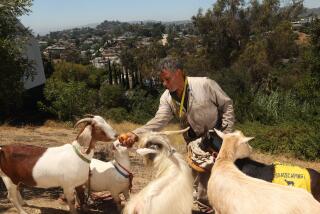A Story of Success That Starts With a Goat
- Share via
When Beatrice Biira was 9, she could never have imagined that a single goat could change her life, or that her life story would become a book. She had never owned a book or a goat--and she had never been to school to learn about life’s possibilities.
Six years later she is touring the United States, speaks English in bell-like tones and is talking in classrooms and on TV about “Beatrice’s Goat” (Atheneum Books for Young Readers, 2001), a story about an extraordinary change in circumstances.
Beatrice grew up in the rolling hills of western Uganda with her mother and five younger brothers and sisters. Their one-room straw hut had a floor of mud, a leaky straw roof and no furniture. The bathroom was an outdoor hole in the earth. The village had no electricity or water, so Beatrice trudged a few miles to the river at least twice each day. She’d fill a huge jug with water, walk home with it balanced on her head, and the family would use it for drinking, cooking, washing and helping food to grow.
With her baby sister in a cloth cocoon on her back, she spent her days helping her mother tend the children and plant cassava and grind it into flour. It was a hard yet peaceful life, lived as it had been for centuries by people of the region.
Only one thing bothered Beatrice--she wanted to learn to read and write. The school that served surrounding villages cost $60 a year for books and uniforms and Beatrice’s mother had never had even a fraction of that amount. Still the girl dreamed of wearing the yellow blouse and blue pinafore that would mark her as a student.
When women in the village formed a crafts-making group to earn extra money, Beatrice’s mother joined. Soon the women heard that animals were being given away by a charity in the far-off city of Kampala. They sent word that they would like to apply, and a representative of Heifer Project International came to visit.
The project, based in Little Rock, Ark., is a nonprofit organization funded by religious groups of many denominations, private gifts and grants. The project started 57 years ago by sending 18 heifer cows to a poor area of Puerto Rico, where sickly children had never tasted milk. It has grown to cover the globe, providing livestock and other living things to 5 million needy families in 140 countries. It has earned widespread praise--including recognition from presidents Carter, Reagan, Bush and Clinton.
Heifer Project works in the most impoverished areas on Earth. Although it does not give medicine, food, clothes or education, it offers a means for families to earn those things. Depending on which animals will thrive in different climates and cultures, the project provides alpacas, bees, camels, chickens, cows, donkeys, ducks, earthworms, fish, goats, geese, horses, llamas, mules, pigs, rabbits, sheep, silkworms, turkeys, water buffalo and yaks.
In the case of Beatrice’s mom, it was a goat. She was one of 10 women in the group to receive one. But first, she was required to learn how to care for it, how to use its manure for fertilizer, how to apportion the milk it would give, so that the family would get healthier and wealthier. Each woman was asked to donate her goat’s first-born female to another needy family, a principle called “passing on the gift.”
It was a quick course in agriculture and economics--lessons the mother learned well, and then taught to her daughter as they built a goat shed together. Then the mother announced that Beatrice was to be in total charge of the goat. Beatrice was so excited she couldn’t sleep. When the goat finally arrived, it was beautiful--and pregnant. It had the sweetest little smile and “chin hairs that curled just so.” Beatrice named it Mugisa, which means Luck. Within weeks Mugisa gave birth to two kids--a male and a female. As agreed, they gave the female to another family and they sold the male.
Beatrice started milking her goat twice a day, feeding each family member one-third of a cup of milk each time, and selling the rest. She put the coins into a small fabric pouch she hung at her waist. When the pouch was full, she would give the coins to her mother. The family desperately needed many things, but Beatrice’s mother decided the coins would be best spent on school for her daughter.
When Heifer Project International looked in on the area a few months later, all the families with goats had begun to do better. But changes at the Biira house were extraordinary: The children were healthier. The hut had wood furniture painted blue. The new roof was of tin and no longer leaked. And Beatrice had made great progress at school.
Two of the visitors on that trip were from American HPI headquarters. When they got home, they couldn’t get Beatrice out of their minds. They said her success story would make a perfect children’s book. She was so special, and yet so typical of millions of poor children around the world. She had taken such perfect care of the goat, and of her whole family. She was smart in school, and would soon know everything that could be taught there.
The Heifer Project staffers decided to chip in and offer to pay the $600 per year tuition at a boarding school in the city of Kampala. If Beatrice went, however, she could only see her family about once a year because there is no transportation to the village from the city.
Beatrice and her mother decided that, if she passed the entrance exam, she would start boarding school when she was 12.
And she did.
In the four years since then, Beatrice has progressed from third grade, where she was first placed, to her junior year of high school. Mugisa has produced more goats and Beatrice’s mother now has a small flock; the family is fed and clothed; and all the Biira children go to school.
*
Beatrice, now 16, still speaks in her African dialect with her family, but otherwise speaks English. She is a serious girl who loves science and has been promised a college scholarship--she plans to become a veterinarian.
She was in Los Angeles recently as part of the nationwide tour to promote “Beatrice’s Goat,” which is No. 3 on the current New York Times bestseller list of children’s picture books and in its third printing.
On the tour, Beatrice visited American schools and churches, signed books at stores, took sightseeing detours--and saw a world she never could have imagined.
Her culture shock was evident along the way. At home, her mother still cooks two meals per day on an open fire outside the hut. At her high school there is more, but not that much. It has plumbing that doesn’t work, so pails line the halls. She is awed, at times to speechlessness, with the seeming super-abundance of food, clothes, gadgets and amenities in the United States. When asked about her trip to Disneyland, her mouth opens, but she cannot speak. How would children in Africa respond to such a place? “They wouldn’t have money to go there,” she said. “And if they had it, they would spend it on other things.”
The idea for “Beatrice’s Goat” had languished at Heifer Project headquarters for years until an accidental meeting with an artist and writer who were fascinated by the subject. Illustrator Lori Lohstoeter and writer Page McBrier, who are neighbors in Connecticut, traveled as guests of the Heifer Project to Beatrice’s village in Africa, where they met Mugisa, Beatrice’s mother, and Beatrice herself.
They came home and produced the simple tale of a mother who created a miracle with her hard work, a child of shining achievement and a goat with a Mona Lisa smile who helped make it all happen.
For more information, www.heifer.org.
More to Read
Sign up for our Book Club newsletter
Get the latest news, events and more from the Los Angeles Times Book Club, and help us get L.A. reading and talking.
You may occasionally receive promotional content from the Los Angeles Times.










